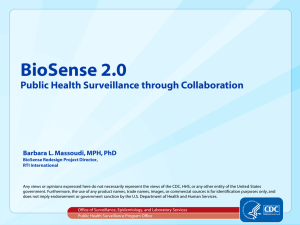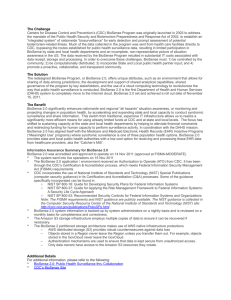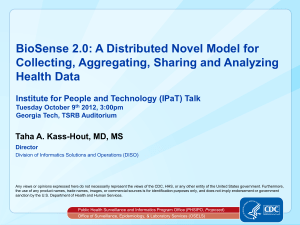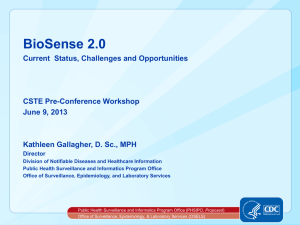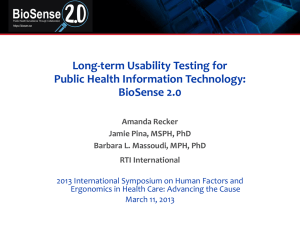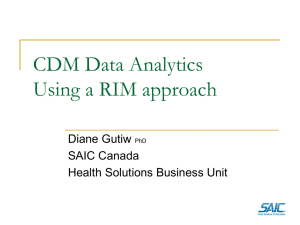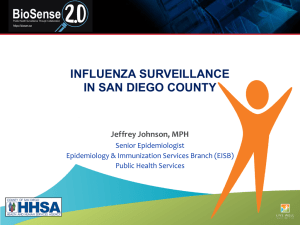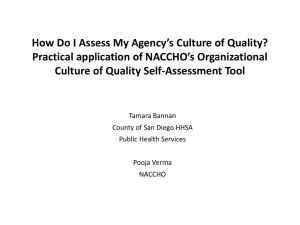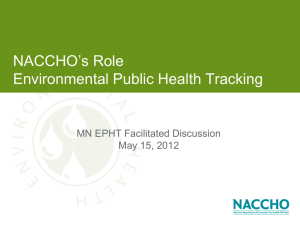What to Consider When Using BioSense 2.0
advertisement
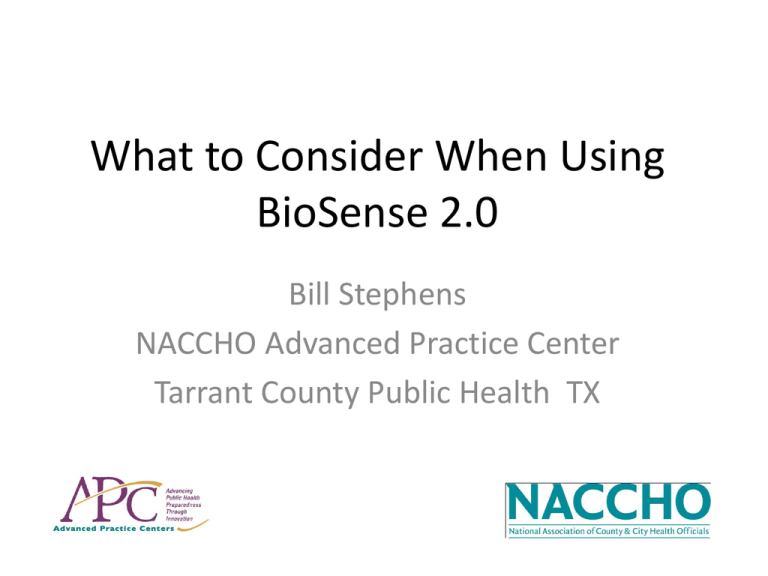
What to Consider When Using BioSense 2.0 Bill Stephens NACCHO Advanced Practice Center Tarrant County Public Health TX Overview • Identify your experience • Consider important questions • Focus on the setup model – Good communication – Identify roles • Resources Identify Your Experience • Sites new to Syndromic Surveillance • Sites with Syndromic experience • More than we can go over today in detail, but NACCHO has a self assessment survey to help start asking the right questions and begin planning: http://naccho.us.qualtrics.com/SE/?SID=SV_8oAIIfcuxjsgNJq New Sites • Consider: – Why you are using BioSense 2.0 – Workforce/personnel required – State and local roles (not system based security roles, but main responsibilities) – Hospital agreements and ASTHO agreement – Data flow (Hosp to HD to Cloud, Hosp to Cloud, Permutations within cloud (i.e. BioSense, ESSENCE, etc.)) – Permissions and system based security roles Experienced Sites • Revisit: – – – – – Why using BioSense Workforce/personnel State and local roles (not security roles, but main responsibilities) Hospital agreements Data flow (Hosp to HD to Cloud, Hosp to Cloud, Permutations within cloud (i.e. BioSense, ESSENCE, etc.)) – Permissions and system roles • Consider: – Business process redesign • Take into account: – maintaining multiple systems (i.e. defining the purpose of each) – End user retraining – Partner education/communications about changes Model Setup • Have to Consider: – Technical AND – Business or Practice issues • Options: – Centralize – Regionalize – Localize Technical Model Considerations • Does the LHD have technical personnel to manage data feeds? • Does the Region have technical personnel to manage data feeds? • Does the State have technical personnel to manage data feeds? • Don’t forget about CDC technical resources Tarrant County Results • Key Lessons Learned – Establishing connectivity is easy, utilizing hardware VPN routers and MIRTH data integration solutions for LHDs and hospitals. – Establishing proper locker configuration based on actual jurisdictional authority needs clear specification in the earliest phases where state may not be the sole access controlling authority – Data validation compared to local or regional baseline system or analytical verification tools expedites BioSense 2.0 validation process – Segmentation of user groups into two broad categories essential for use-case development and training- new or experienced users. – As usual, one size BioSense implementation does not fit all. Tarrant County Technical Model Best Practices • Obviously not every State, Regional, and Local environment will fit. But we’ve found success: – Regional model supported by local context – Enhance local capacity – State plays more of a supporting and encouraging role and coordinating regions to be effective network across the state • very important and nice for a state the size of TX – would be difficult for state staff to support whole state Business/Practice Model Considerations • “Natural Cooperation” based on daily existing relationships with hospital staff (i.e. IPs) • Data quality – Context counts and locals have it • Anomaly (DQ or event) detection requires good communication and interoperability with partners – often best through local relationships • Response protocols – Essential to buy-in from staff and partners and must be locally focused Resources • Tarrant County Biosurveillance Compendium: – Training and exercise materials – Community building materials: • • • • – – – – Federal partners First Responders Medical Community Schools HIPAA guidance How to implement Syndromic Surveillance Literature Response Protocols • CDC Technical Support • ASTHO staff convene governance over shared resources in the cloud • NACCHO and CSTE staff can foster peer to peer assistance, create best practice documentation, and foster regional communities of practice • ISDS provides the Syndromic Surveillance Community of Practice, research and innovation, Meaningful Use guidance, and a NACCHO sponsored Syndromic 101 course Final Thoughts • Re-enforce hybrid model – Region and local focused surveillance that meets minimal standards that enhance the sharing across jurisdictions – Overall fits way HIT is evolving – i.e. regional HIEs that are stitched together across the state and all talking over interoperability standards • Next steps of the pilot is to work with key informants – Developing use cases specific to the new BioSense platform – how do we get this new tool into routine Epidemiology and practice? – Translating between state perspective and local perspective • Coordinating interventions • Provide value for hospitals and providers • For those who want more details, Our partners at ASTHO and RTI will be hosting webinars on “Transport” and “Security” for BioSense 2.0 – look for those in the next two weeks Questions? Bill Stephens Tarrant County Public Health Advanced Practice Center (817) 321-4730 wfstephens@tarrantcountytx.gov For more resources, go to apc.naccho.org
